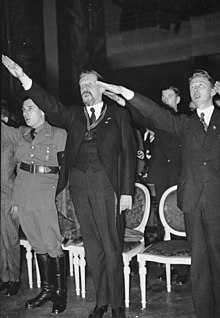Eugen Fischer
Eugen Fischer | |
|---|---|
 Eugen Fischer in 1934 | |
| Born | 5 July 1874 |
| Died | 9 July 1967 (aged 93) |
| Nationality | German |
| Education | University of Freiburg |
| Occupation | Professor |
| Known for | Nazi eugenics |
| Political party | Nazi Party |
Eugen Fischer (5 July 1874 – 9 July 1967) was a German professor of medicine, anthropology, and eugenics, and a member of the Nazi Party. He served as director of the Kaiser Wilhelm Institute of Anthropology, Human Heredity, and Eugenics, and also served as rector of the Frederick William University of Berlin.
Fischer's ideas informed the Nuremberg Laws of 1935 which served to justify the Nazi Party's belief in German racial superiority to other "races", and especially the Jews.[1] Adolf Hitler read Fischer's work while he was imprisoned in 1923 and he used Fischer's eugenic notions in support of a pure Aryan society in his manifesto Mein Kampf (My Struggle).[1]
After the war, he completed his memoirs, it is believed that in them he lessened his role in the genocidal programme of Nazi Germany. He died in 1967.
Life[edit]
Fischer was born in Karlsruhe, Grand Duchy of Baden, in 1874. He studied medicine, folkloristics, history, anatomy, and anthropology in Berlin, Freiburg and Munich.[2] In 1918, he joined the Anatomical Institute in Freiburg,[3] part of the University of Freiburg.[4]
Early work[edit]

In 1906, Fischer conducted field research in German South West Africa (now Namibia). He studied the Basters, offspring of German or Boer men and Black African (Khoekhoe) women in that area. His study concluded with a call to prevent the production of a mixed race by the prohibition of mixed marriages such as those which he had studied. It included human experimentation on the Herero and Namaqua people.[5] He argued that while the existing "Mischling" descendants of the mixed marriages might be useful for Germany, he recommended that they should not continue to reproduce. His recommendations were followed and by 1912 interracial marriage was prohibited throughout the German colonies.[6][7] As a precursor to his experiments on Jews in Nazi Germany, he collected bones and skulls for his studies, in part from medical experimentation on African prisoners of war in Namibia during the Herero and Namaqua Genocide. Fischer also sterilized Herero women.[8][9]
His ideas which were related to the maintenance of the apparent purity of races, influenced future German Nazi legislation on race, including the Nuremberg laws.[7]
In 1927, Fischer was a speaker at the World Population Conference which was held in Geneva, Switzerland.[10] In the same yer, Fischer became the director of the Kaiser Wilhelm Institute of Anthropology, Human Heredity, and Eugenics (KWI-A), a role for which he'd been recommended the prior year by Erwin Baur.[11]
Nazi Germany[edit]

In the years from 1937–1938 Fischer and his colleagues analysed 600 children in Nazi Germany who were descended from French-African soldiers who occupied western areas of Germany after the First World War and were known as the Rhineland Bastards; the children were subsequently subjected to sterilization.[12]

Fischer did not officially join the Nazi Party until 1940.[13] However, he was influential with National Socialists early on. Adolf Hitler read his two-volume work, Principles of Human Heredity and Race Hygiene (first published in 1921 and co-written by Erwin Baur and Fritz Lenz) while incarcerated in 1923 and used its ideas in Mein Kampf.[14] He also wrote The Rehoboth Bastards and the Problem of Miscegenation among Humans (1913) (German: Die Rehobother Bastards und das Bastardierungsproblem beim Menschen), a field study which provided context for later racial debates, influenced German colonial legislation. Nuremberg laws.[15]
Under the Nazi regime, Fischer developed the physiological specifications such as skull dimensions which were used to determine racial origins, and he developed the Fischer–Saller scale for hair colour. He and the members of his team experimented on Gypsies and African-Germans, drawing their blood and measuring their skulls. After directing the Kaiser Wilhelm Institute of Anthropology, Human Heredity, and Eugenics, he was succeeded by Otmar Freiherr von Verschuer, who tutored Josef Mengele when he was active at Auschwitz.
In 1933 Fischer signed the Vow of allegiance of the Professors of the German Universities and High-Schools to Adolf Hitler and the National Socialistic State. In 1933, Adolf Hitler appointed him rector of the Frederick William University of Berlin, now Humboldt University.[16] Fischer retired from the university in 1942. Otmar Freiherr von Verschuer was a student of Fischer.[17][18]
Efforts to return the Namibian skulls which were taken by Fischer were started with an investigation which was conducted by the University of Freiburg in 2011 and they were completed with the return of the skulls in March 2014.[19][20][21]
In 1944, Fischer intervened in an attempt to get his friend Martin Heidegger, the Nazi philosopher, released from service in the Volkssturm militia. However, Heidegger had been released from service when Fischer's letter arrived.[22]: 332–3
Works[edit]

1909 to 1949[edit]
- Fischer, Eugen. 1899. "Beiträge zur Kenntniss der Nasenhöhle und des Thränennasenganges der Amphisbaeniden", Archiv für Mikroskopische Anatomie. 55:1, pp. 441–478.
- Fischer, Eugen. 1901. "Zur Kenntniss der Fontanella metopica und ihrer Bildungen". Zeitschrift für Morphologie und Anthropologie.4:1. pp. 17–30.
- Fischer, Eugen, Professor an der Universität Freiburg i. Br. 1906. "Die Variationen an Radius und Ulna des Menschen". Zeitschrift für Morphologie und Anthropologie. Vol. 9. No. 2.
- Fischer, Eugen. 1908. Der Patriziat Heinrichs III und Heinrichs IV. Tübingen: J.C.B. Mohr (Paul Siebeck). Fischer's PhD thesis.
- Maass, Alfred. Durch Zentral-Sumatra. Berlin: Behr. 1910. Additional contributing authors: J.P. Kleiweg de Zwaan and E. Fischer.
- Fischer, Eugen. 1913.Die Rehobother Bastards und das Bastardierungsproblem beim Menschen: anthropologische und ethnographiesche Studien am Rehobother Bastardvolk in Deutsch-Südwest-Afrika, ausgeführt mit Unterstützung der Kgl. preuss, Akademie der Wissenschaften. Jena: G. Fischer.
- Gaupp, Ernst Wilhelm Theodor. Eugen Fischer (ed.) 1917. August Weismann: sein Leben und sein Werk. Jena: Verlag von Gustav Fischer.
- Schwalbe, G. and Eugen Fischer (eds.). Anthropologie. Leipzig: B.G. Teubner, 1923.
- Fischer, E. and H.F.K. Günther. Deutsche Köpfe nordischer Rasse: 50 Abbildungen mit Geleitwarten. Munich: J.F. Lehmann. 1927.
- Fischer, Eugen and Gerhard Kittel. Das antike Weltjudentum : Tatsachen, Texte, Bilder. Hamburg: Hanseatische Verlagsanstalt, 1943.[23]
1950 to 1959[edit]
- Sarkar, Sasanka Sekher; Eugen Fischer and Keith Arthur, The Aboriginal Races of India, Calcutta: Bookland. 1954.
- Fischer, Eugen. Begegnungen mit Toten: aus den Erinnerungen eines Anatomen. Freiburg: H.F. Schulz. 1959.
See also[edit]
- Karl Binding
- Josef Mengele
- Nazi eugenics
- Nazi human experimentation
- Nazi racial theories
- Otmar Freiherr von Verschuer
- Racial policy of Nazi Germany
- Racism in Germany
- Scientific racism
- Subsequent Nuremberg trials
- Doctors' Trial
- Anthropometry
- Fischer-Saller scale
- Shark Island Concentration Camp
- Rhineland Bastards
Notes[edit]
- ^ a b Anderson, Ingrid L. (2016-05-26). Ethics and Suffering since the Holocaust: Making Ethics "First Philosophy" in Levinas, Wiesel and Rubenstein. Routledge. ISBN 9781317298359.
- ^ Max-Planck-Gesellschaft - Archive. "Fischer, Eugen". Archived from the original on 2014-08-19.
- ^ "Eugen Fischer".
- ^ Eugen Fischer (1921). "Bitte des anatomischen Instituts Freiburg i.B."
- ^ "Herero and Namaqua Genocide - Herero Genocide Nama Genocide". Archived from the original on 2011-12-09. Retrieved 2014-01-19.
- ^ Holocaust Encyclopedia, p. 420
- ^ a b Friedlander 1997, p. 11
- ^ http://www.ezakwantu.com/Gallery%20Herero%20and%20Namaqua%20Genocide.htmMedical[permanent dead link] experimentation in Africa
- ^ Lusane, Clarence (2002-12-13). Hitler's black victims: The historical experiences of Afro-Germans, European Blacks, Africans, and African Americans in the Nazi era. Taylor & Francis. p. 44. ISBN 9780415932950.
sterilization of herero women.
- ^ Ross, Edward Alsworth (October 1927). "Birth Control Review" (PDF). World Population Conference. Archived from the original (PDF) on 2020-05-14. Retrieved 2019-09-02.
- ^ Schmul 2003, p. 25.
- ^ Bioethics: an anthology Helga Kuhse, Peter Singer page 232 Wiley-Blackwell 2006
- ^ "Human biodiversity: genes, race, and history", Jonathan M. Marks. Transaction Publishers, 1995. p. 88. ISBN 0202020339, 9780202020334.
- ^ A. E. Samaan (2013). From a Race of Masters to a Master Race: 1948 To 1848. A.E. Samaan. p. 539. ISBN 978-1626600003.
- ^ Holocaust Encyclopedia p. 420.
- ^ Lasalle, Ferdinand. "Rektoratsreden im 19. und 20. Jahrhundert – Online-Bibliographie - Friedrich-Wilhelms-Universität Berlin". www.historische-kommission-muenchen-editionen.de. Retrieved 19 April 2018.
- ^ Michael H. Kater (2011). "The Nazi Symbiosis: Human Genetics and Politics in the Third Reich". Bulletin of the History of Medicine. 85: 515–516. doi:10.1353/bhm.2011.0067. S2CID 72443192.
- ^ Randall Hansen; Desmond King (2013). Sterilized by the State: Eugenics, Race, and the Population Scare in Twentieth-Century. Cambridge University Press. p. 328. ISBN 978-1107434592.
- ^ "Repatriation of Skulls from Namibia University of Freiburg hands over human remains in ceremony". 2014. Archived from the original on 2014-04-03.
- ^ Archived at Ghostarchive and the Wayback Machine: Namibia Press Agency (7 March 2014). "NAMPA: WHK skulls repatriated to Namibia 07 March 2014". Retrieved 19 April 2018 – via YouTube.
- ^ "Germany to send back 35 skulls". newera.com.na. 28 February 2014. Archived from the original on 9 April 2014. Retrieved 19 April 2018.
- ^ Safranski, Rüdiger (1999). Martin Heidegger: Between Good and Evil. Cambridge (MAss): Harvard University Press.
- ^ Das Antike Weltjudentum - Forschungen zur Judenfrage. 1944.
References[edit]
- Baumel, Judith Tydor (2001). The Holocaust Encyclopedia. Yale University Press. ISBN 0-300-08432-3.
- Black, Edwin (2004). War Against the Weak: Eugenics and America's Campaign to Create a Master Race. Thunder's Mouth Press. ISBN 1-56858-321-4.
- Fangerau H.; Müller I. (2002). "Das Standardwerk der Rassenhygiene von Erwin Baur, Eugen Fischer und Fritz Lenz im Urteil der Psychiatrie und Neurologie 1921-1940". Der Nervenarzt. 73 (11): 1039–1046. doi:10.1007/s00115-002-1421-1. PMID 12430045. S2CID 42189711.
- Mendes-Flohr, Paul R. (1995). The Jew in the Modern World: A Documentary History. Oxford University Press US. ISBN 0-19-507453-X.
- Schmuhl, Hans-Walter. "The Kaiser Wilhelm Institute for Anthropology, Human heredity and Eugenics, 1927-1945", Boston Studies in the Philosophy of Science vol. 259, Wallstein Verlag, Göttingen, 2003
- Weindling P. (1985). "Weimar eugenics: The kaiser wilhelm institute for anthropology, human heredity and eugenics in social context". Annals of Science. 42 (3): 303–318. doi:10.1080/00033798500200221. PMID 11620696.
- Friedlander, Henry. 1997. The origins of Nazi genocide: from euthanasia to the Final Solution. University of North Carolina Press. ISBN 0-8078-2208-6 ISBN 0807846759.
External links[edit]
- Book Review of The Rehoboth Bastards in Nature (1913)
- 2004 Newspaper Article regarding The Rehoboth Bastards
- The Rehoboth Bastards (Photo Album)
- Herero and Namaqua Genocide - Galerie Ezakwantu
- Works by Eugen Fischer at Project Gutenberg
- Lusane, Clarence (2002-12-13). Hitler's black victims: The historical experiences of Afro-Germans, European Blacks, Africans, and African Americans in the Nazi era. Taylor & Francis. p. 44. ISBN 978-0-415-93295-0.
sterilization of herero women.
- 1874 births
- 1967 deaths
- Physicians from Karlsruhe
- German eugenicists
- Herero and Namaqua genocide perpetrators
- Members of the Prussian Academy of Sciences
- Physicians in the Nazi Party
- People from the Grand Duchy of Baden
- University of Freiburg alumni
- Academic staff of the University of Freiburg
- Ludwig Maximilian University of Munich alumni
- Academic staff of the University of Würzburg
- Academic staff of the Humboldt University of Berlin
- Nazi eugenics
- People associated with the Kaiser Wilhelm Institute of Anthropology, Human Heredity, and Eugenics
- Max Planck Institute directors
- Recipients of the Cothenius Medal
